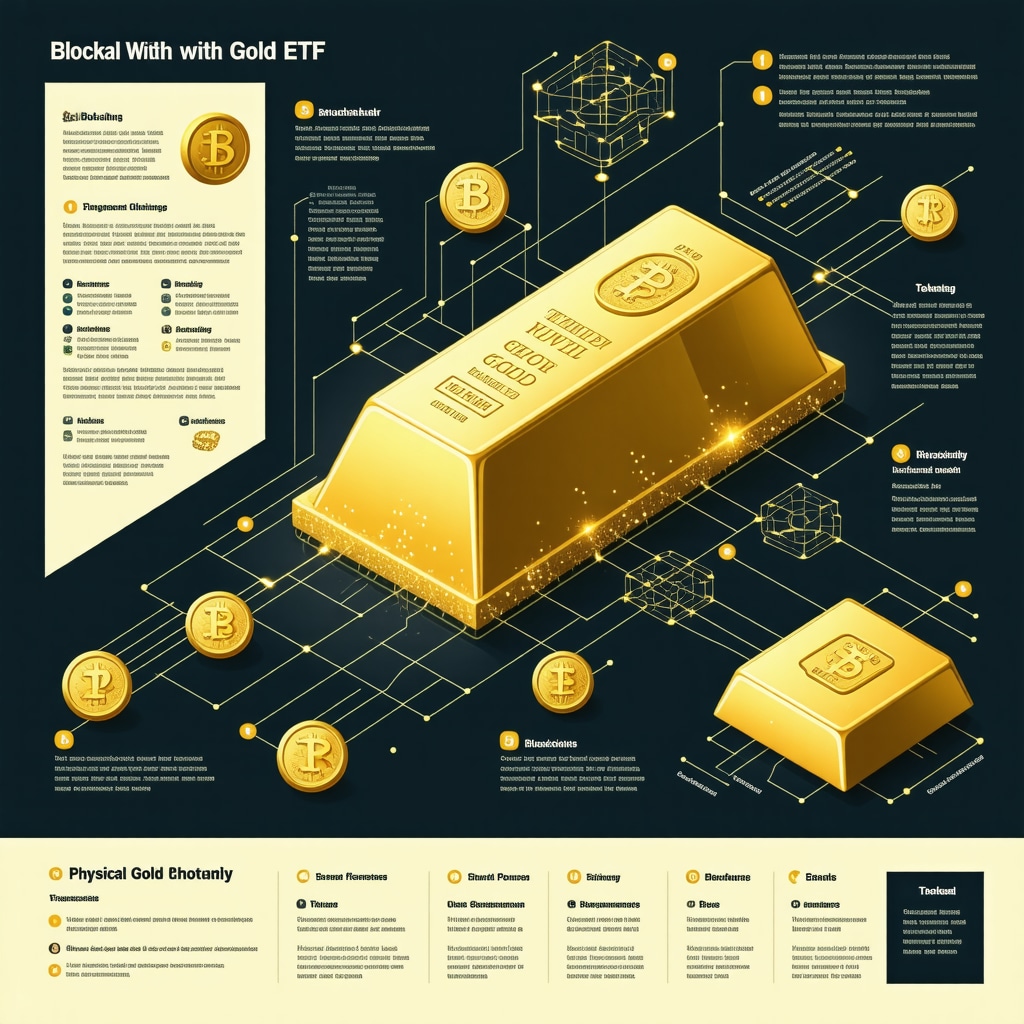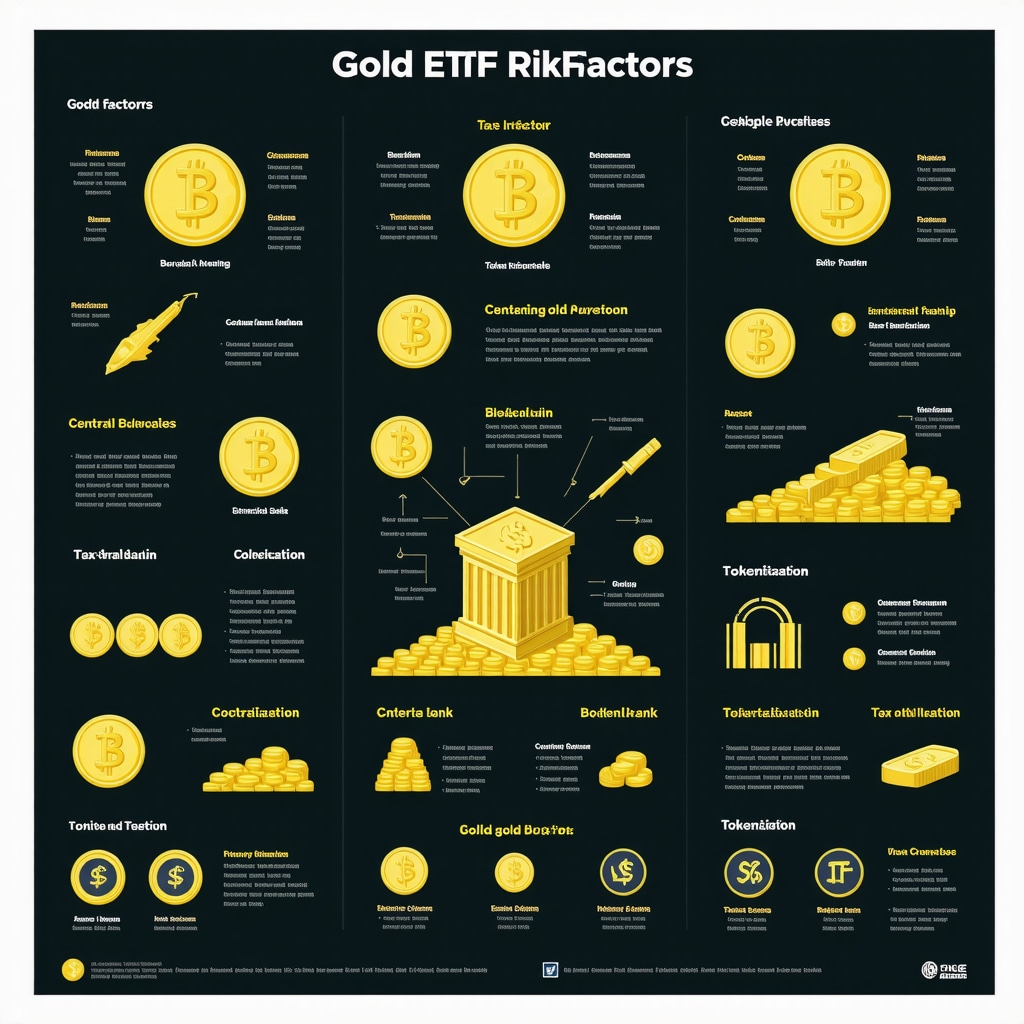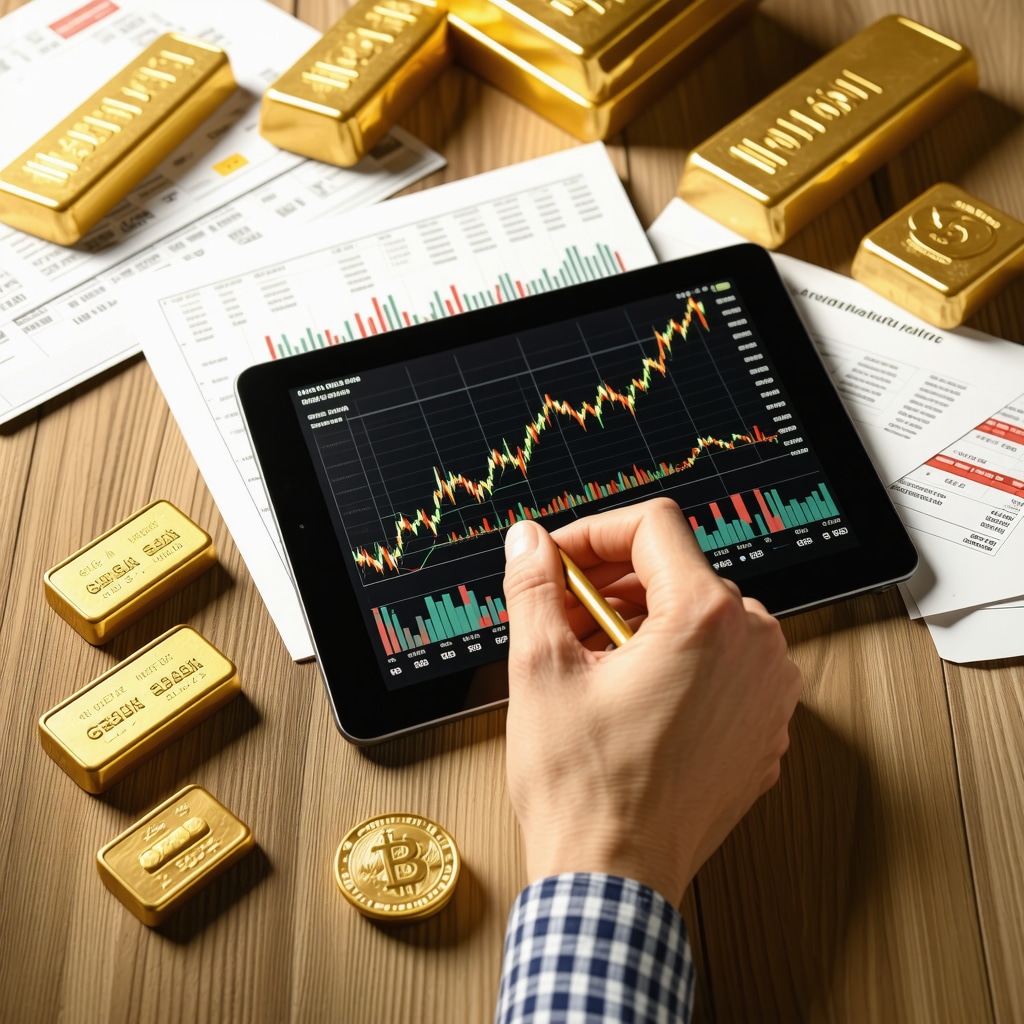Why Gold ETFs Might Just Be Your Next Best Financial Friend
If you’ve ever caught yourself gazing wistfully at shiny gold bars in documentaries or wondered why your grandma always tucked a gold coin away for a rainy day, you’re not alone. Gold has been a symbol of wealth and safety for centuries, and today, it’s easier than ever to get in on the action — without the hassle of a bulky safe or the paranoia of a secret hiding spot. Enter Gold ETFs (Exchange-Traded Funds), the modern gateway to gold investing.
Gold ETFs let you own a slice of gold’s value, traded just like stocks, blending the glitter of precious metals with the convenience of the stock market. But how do you start? What should you watch out for? And is this really the golden ticket or just another shiny distraction?
Gold ETFs 101: What Are They and Why Should You Care?
Imagine a fund that owns actual gold or gold futures, and you buy shares representing a fraction of that treasure. That’s a Gold ETF in a nutshell. It’s like owning gold without the headaches of storage and security. Plus, you get the liquidity of stocks, which means you can buy or sell shares anytime during market hours.
For beginners, this is a fantastic way to dip your toes into gold investing without the steep learning curve of physical gold or mining stocks. Plus, with ETFs, you avoid the risks linked to counterfeit coins or shady dealers. A reputable ETF is backed by actual gold held by trusted custodians — transparency and trustworthiness baked right in.
How to Choose Your Golden Ticket: Picking the Right Gold ETF
Not all Gold ETFs are created equal. Some track the price of physical gold bullion, while others might track gold futures or gold mining companies. Your choice depends on your investment goals and risk appetite. For a pure play on gold prices, ETFs like SPDR Gold Shares (GLD) or iShares Gold Trust (IAU) are popular options.
Keep an eye on the expense ratio (the annual fee), liquidity, and the fund’s size. Lower fees and high liquidity usually mean easier trading and better returns in the long run. And remember, while Gold ETFs are generally safer than mining stocks, they’re still susceptible to market fluctuations and economic factors.
Is Gold ETF Investing Just a Fad or a Smart Hedge in a Volatile World?
With inflation worries, geopolitical tensions, and unpredictable stock markets, many investors turn to gold as a safe haven. Gold ETFs provide a nimble way to hedge against these uncertainties without locking up your cash in physical bars. According to Investopedia, gold ETFs have become a mainstream tool for portfolio diversification, offering both stability and growth potential.
But beware: jumping on the bandwagon without understanding market dynamics can lead to disappointment. It’s crucial to stay informed about factors like central bank gold purchases affecting gold prices, as these can significantly sway the market.
Ready to Shine? Your Next Steps Toward Gold ETF Investing
Start by opening a brokerage account if you don’t have one. Next, research the top Gold ETFs, comparing their expense ratios, holdings, and historical performance. Consider your investment timeline and risk tolerance carefully. And never underestimate the value of ongoing education—whether it’s reading market analysis or exploring essential gold investing tips for beginners.
Have you dipped your toes into Gold ETFs yet? Share your experiences or questions in the comments below — because every golden journey deserves a great conversation.
Delving Deeper: Advanced Strategies to Maximize Your Gold ETF Portfolio
Once you’ve grasped the basics of Gold ETFs, it’s time to explore how to harness their full potential. Diversification within your gold investments can be a game-changer. Consider blending ETFs that track physical gold with those focused on gold mining stocks or futures. This balanced approach can help you capture upside growth while mitigating risks associated with any single segment of the gold market.
Moreover, timing and market cycles matter. Monitoring macroeconomic indicators such as inflation rates, currency fluctuations, and geopolitical developments can help you anticipate gold price movements and adjust your position accordingly. For instance, central bank gold purchases have historically influenced market dynamics significantly; gaining insights into these trends can offer a strategic edge (source).
The Regulatory Landscape and Its Impact on Gold ETFs
It’s vital to understand the regulatory framework governing Gold ETFs. Regulatory changes can affect fund transparency, custody arrangements, and trading practices. For example, stricter disclosure requirements can enhance investor confidence, whereas regulatory uncertainty might increase volatility. Staying informed about these developments ensures your investment strategy remains resilient in a shifting legal environment.
Can Gold ETFs Sustain Their Appeal Amid Rising Digital Asset Popularity?
With the surge of cryptocurrencies and decentralized finance, a pressing question for seasoned investors is: can Gold ETFs maintain their status as a preferred safe haven? While digital assets offer innovation and high growth potential, their volatility and regulatory ambiguity contrast sharply with gold’s centuries-old reputation for stability and tangibility. Gold ETFs bridge the gap by offering liquidity and ease of trading without sacrificing the intrinsic value of a physical asset.
Industry analyses suggest that gold’s enduring appeal as a hedge against inflation and market uncertainty remains robust despite digital asset trends. According to the World Gold Council, gold ETFs continue to attract significant inflows globally, underpinning their relevance in diversified portfolios (World Gold Council).
Practical Tips to Enhance Your Gold ETF Investment Experience
To elevate your gold ETF investment game, consider these expert tips: regularly review your portfolio’s gold exposure relative to your overall asset allocation; leverage dollar-cost averaging to smooth out market volatility; and stay abreast of economic reports that influence gold prices. Additionally, explore resources like proven gold trading techniques to refine your approach.
Engaging with a community of fellow investors can also provide valuable insights and diverse perspectives. If you have experiences or questions about integrating Gold ETFs into your portfolio, please share your thoughts in the comments below. Your insights might just be the golden advice someone else needs!
Strategic Allocation: Leveraging Gold ETFs to Fortify Your Portfolio Against Inflation and Currency Risks
In the current macroeconomic landscape marked by persistent inflationary pressures and currency volatility, integrating Gold ETFs into your portfolio isn’t just about diversification—it’s a tactical shield. Unlike traditional assets, gold exhibits a unique inverse correlation with the US dollar and inflation indexes, offering a buffer against purchasing power erosion. Seasoned investors often allocate a calibrated percentage of their portfolio to Gold ETFs, typically ranging between 5% to 15%, depending on their risk tolerance and investment horizon.
However, the sophistication lies in the choice of ETF types. Physical gold-backed ETFs provide direct exposure to spot gold prices, ideal for preserving capital, while leveraged gold ETFs or those tracking gold futures can amplify returns but with higher risk profiles suitable for tactical trading. Employing a blend of these instruments can optimize both capital preservation and growth. For example, tactically increasing exposure to leveraged Gold ETFs during anticipated inflation spikes might yield superior returns, while leaning on physical-backed ETFs during market downturns safeguards value.
How Can Investors Navigate the Complex Tax Implications of Gold ETF Investments?
Tax treatment remains a nuanced aspect of Gold ETF investing that demands expert attention. In the United States, for instance, gains from gold ETFs are typically taxed as collectibles at a maximum rate of 28%, rather than the more favorable long-term capital gains rates applicable to stocks and bonds. This distinction arises because gold ETFs represent ownership in physical gold, categorizing them differently from conventional equity ETFs. Furthermore, the timing of gains realization impacts tax liabilities significantly, with short-term trades attracting ordinary income tax rates.
International investors should also consider jurisdiction-specific regulations, as some countries may impose additional taxes on precious metal holdings or offer exemptions under certain investment vehicles. Consulting with a tax advisor familiar with cross-border precious metals taxation is indispensable for optimizing after-tax returns. Detailed guidance on tax nuances can be found in authoritative resources such as the IRS Publication 550: Investment Income and Expenses.
Technological Innovations: How Blockchain and Tokenization Are Reshaping Gold ETF Accessibility
The convergence of blockchain technology and asset tokenization is redefining how investors interact with gold assets. Tokenized Gold ETFs leverage distributed ledgers to represent fractional ownership of gold-backed securities, increasing transparency, reducing settlement times, and lowering barriers to entry. This democratization enables micro-investments, allowing retail investors to acquire gold exposure with unprecedented liquidity and minimal capital.
Moreover, blockchain facilitates enhanced provenance tracking of physical gold, addressing long-standing concerns regarding authenticity and ethical sourcing. Some cutting-edge Gold ETFs now incorporate these technologies to bolster investor confidence and comply with rigorous environmental, social, and governance (ESG) criteria.
As these innovations mature, traditional Gold ETF providers may face competition from decentralized platforms offering gold-backed tokens. Staying abreast of these developments is crucial for forward-looking investors aiming to harness the best of both worlds: the stability of gold and the agility of digital finance.

Integrating Gold ETFs Into Multi-Asset Strategies: Beyond the Basics
Gold ETFs can play a pivotal role in multi-asset portfolios, especially when combined with fixed income, equities, and alternative investments. Advanced portfolio construction techniques, such as mean-variance optimization and factor-based investing, can quantify gold’s contribution to risk-adjusted returns. For instance, incorporating Gold ETFs as a volatility hedge during periods of market stress can improve overall portfolio resilience.
Dynamic asset allocation models also recommend adjusting gold exposure based on economic cycles—for example, increasing holdings during geopolitical instability or tightening monetary policy phases. This approach requires continuous market intelligence and a disciplined rebalancing strategy to capture gold’s protective qualities without sacrificing growth potential.
For institutional investors and sophisticated retail investors alike, utilizing derivatives like options on Gold ETFs can further customize risk profiles, enabling strategies such as covered calls or protective puts. These techniques can enhance yield or provide downside protection, respectively, adding an additional layer of sophistication to gold investing.
What Are the Key Risk Factors Unique to Gold ETFs That Experienced Investors Should Monitor?
While Gold ETFs mitigate many risks associated with physical gold ownership, seasoned investors must remain vigilant about unique vulnerabilities. These include counterparty risk related to custodians and counterparties in futures-based ETFs, liquidity risk in less-traded funds, and tracking error that can cause ETF performance to diverge from underlying gold prices. Additionally, geopolitical events affecting mining regions or supply chains can indirectly impact gold prices and consequently ETF valuations.
Another subtle risk involves regulatory shifts—such as changes in securities laws or commodities regulations—that can alter ETF structures or tax treatments overnight. Therefore, maintaining a comprehensive risk management framework, including scenario analysis and stress testing, is critical for long-term success.
For an in-depth exploration of these risk considerations, consult specialized financial risk management literature and stay engaged with updates from regulatory bodies like the SEC or FINRA.
Ready to elevate your gold investment strategy? Dive deeper into advanced Gold ETF tactics and stay ahead of market trends by subscribing to our expert insights newsletter. Your journey towards mastering gold investing starts here!
Mastering the Hidden Risks of Gold ETFs: What Every Expert Investor Should Monitor
While Gold ETFs eliminate many hassles linked to physical gold, they carry nuanced risks that can catch even experienced investors off guard. Custodial counterparty risk, especially in futures-based ETFs, demands rigorous due diligence on fund managers and custodians. Liquidity risk is another subtle threat; smaller or niche Gold ETFs may suffer from low trading volumes, causing wider bid-ask spreads and potential slippage during volatile market conditions.
Additionally, tracking error—the divergence between the ETF’s performance and the underlying gold price—can erode returns over time. Such discrepancies often arise from management fees, operational costs, or imperfect futures contracts replication. Staying vigilant about geopolitical risks affecting gold mining regions or supply disruptions is equally critical, as these can indirectly influence ETF valuations.
Regulatory shifts present another layer of uncertainty. Unexpected changes in securities or commodities regulations may alter ETF structures, custody protocols, or tax treatments overnight. Hence, maintaining a robust risk management framework, including stress testing and scenario analysis, is indispensable for portfolio resilience. For a deep dive into these risk vectors, consult regulatory updates from the SEC and FINRA as well as specialized financial risk literature.
How Can Investors Strategically Navigate Tax Complexities in Gold ETF Holdings?
Taxation on Gold ETFs is an intricate subject that significantly impacts net returns. In the United States, gains from gold ETFs are generally treated as collectible gains, subject to a maximum rate of 28%, rather than the more favorable long-term capital gains rates applicable to typical equity ETFs. This is because Gold ETFs are classified as owning physical gold rather than securities.
Moreover, short-term trades attract ordinary income tax rates, making holding periods a critical consideration in tax planning. International investors face additional layers of complexity, as jurisdiction-specific rules may impose withholding taxes, VAT, or exemptions depending on the type of gold investment vehicle. Consulting with tax professionals familiar with cross-border precious metals taxation is essential to optimize after-tax returns.
For authoritative guidance, IRS Publication 550: Investment Income and Expenses remains a definitive resource outlining key tax treatments relevant to precious metal investments.
Harnessing Central Bank Gold Purchase Trends to Fine-Tune Gold ETF Strategies
Central bank gold acquisitions have emerged as a potent force shaping gold price trajectories globally. Understanding these dynamics can sharpen your timing and asset allocation decisions within Gold ETF portfolios. Central banks often increase purchases during periods of geopolitical uncertainty or to diversify reserves away from fiat currencies, driving demand and upward price momentum.
Monitoring such activities enables investors to anticipate market inflection points and adjust exposures accordingly. Our detailed analysis on how central bank gold purchases affect market dynamics offers valuable insights into these pivotal trends.
Integrating these macro factors with technical analysis and broader market intelligence empowers investors to craft nuanced Gold ETF strategies that capitalize on emerging opportunities while mitigating risks.
Why Blockchain Tokenization Could Revolutionize Gold ETF Accessibility and Transparency
Blockchain-enabled tokenization of gold assets promises to transform the traditional Gold ETF landscape by enhancing accessibility, transparency, and trust. By representing fractional ownership on immutable distributed ledgers, tokenized Gold ETFs reduce settlement times and enable micro-investing with minimal capital outlay.
Moreover, blockchain facilitates provenance tracking, addressing concerns regarding gold authenticity and ethical sourcing — increasingly important for ESG-conscious investors. Some pioneering Gold ETFs now adopt these technologies to boost investor confidence and align with evolving regulatory expectations.
As decentralized finance platforms gain traction, traditional Gold ETFs may face competitive pressure from tokenized gold solutions that blend gold’s intrinsic value with blockchain’s agility. Staying informed on this frontier technology is crucial for investors aiming to remain at the vanguard of gold investing.
Ready to Elevate Your Gold ETF Expertise? Share Your Insights and Explore More
Whether you’re navigating risk management, tax strategies, or innovative blockchain applications in Gold ETFs, your perspective matters. Engage with our community by sharing your experiences or questions below — together, we can foster smarter, more resilient gold investment strategies.
For further expert strategies, explore our comprehensive guides like top gold investment strategies to boost portfolio returns and mastering gold trading proven techniques for 2025 success.

Expert Insights & Advanced Considerations
Understanding the Nuances of Custodial and Counterparty Risks
While Gold ETFs offer convenience and liquidity, seasoned investors must scrutinize the custodial arrangements underpinning these funds. Futures-based Gold ETFs introduce additional layers of counterparty risk that can affect tracking accuracy and fund solvency. A rigorous due diligence process involving fund managers’ transparency, custodian reputation, and operational safeguards is essential to mitigate these subtle vulnerabilities.
Dynamic Asset Allocation Tailored to Macroeconomic Indicators
Incorporating Gold ETFs into portfolios dynamically based on inflation data, currency strength, and geopolitical signals can optimize returns. Seasoned investors often adjust gold exposure upward during inflation spikes or monetary tightening phases, leveraging both physical-backed and leveraged ETFs to balance capital preservation with growth potential effectively.
Leveraging Blockchain Tokenization to Enhance Transparency and Accessibility
The advent of blockchain-enabled tokenized Gold ETFs is revolutionizing market participation by enabling fractional ownership, improving settlement efficiency, and ensuring provenance tracking. This technological innovation not only democratizes gold investing but also aligns with ESG principles, thereby appealing to a new wave of conscientious investors.
Strategic Tax Planning to Maximize After-Tax Returns
Tax implications for Gold ETF investors are complex and vary by jurisdiction. In the U.S., classification as collectibles imposes higher tax rates, which demands sophisticated tax planning strategies such as optimizing holding periods and consulting specialized advisors to navigate cross-border regulations and minimize liabilities.
Incorporating Central Bank Gold Purchase Trends for Market Timing
Central bank gold acquisitions significantly influence global gold price trajectories. Monitoring these trends provides actionable insights for timing Gold ETF exposures, allowing investors to anticipate demand surges and geopolitical risk premiums, as detailed in our analysis of central bank gold purchases affecting market dynamics.
Curated Expert Resources
World Gold Council Research Hub: Comprehensive data and analysis on gold market trends, central bank activities, and ETF flows, essential for understanding market fundamentals.
IRS Publication 550: Investment Income and Expenses: Authoritative guidance on tax treatment of precious metals investments, crucial for sophisticated tax planning.
Gold ETF Strategies: Building a Resilient Portfolio Today: A detailed strategic guide for optimizing gold ETF allocations in diversified portfolios.
Mastering Gold Trading: Proven Techniques for 2025 Success: Advanced trading methodologies to navigate volatile markets and enhance returns.
How Central Bank Gold Purchases Affect Market Dynamics: In-depth analysis of macroeconomic forces shaping gold prices and investment timing.
Final Expert Perspective
In an era of increasing economic complexity and technological transformation, mastering Gold ETFs demands both a macro-level understanding of global influences and micro-level attention to fund structures and tax implications. Gold ETFs remain a vital instrument for hedging inflation, enhancing portfolio resilience, and accessing the intrinsic value of physical gold with market agility. By integrating expert insights on risk management, dynamic allocation, and emerging blockchain innovations, investors can refine their strategies to thrive amid 2025’s challenges and opportunities. Engage with this evolving landscape by exploring advanced resources and sharing your professional perspectives to elevate your gold investing acumen.











This piece did a great job demystifying Gold ETFs — the grandma-with-a-coin imagery really resonated with me. I started with a small position in IAU two years ago as a hedge and used dollar-cost averaging to avoid trying to time spikes tied to geopolitical headlines. A few practical takeaways from my experience: prioritize low expense ratios and high liquidity (GLD/IAU are solid for that), keep physical-backed ETFs if your goal is preservation (avoid leveraged/futures funds unless you know the risks), and track your holding period carefully because of collectible tax treatment in the U.S. I also found it helpful to set a target allocation (I use 7–8% of my portfolio) and rebalance annually rather than reacting to daily price moves. Has anyone experimented with tokenized gold products alongside traditional ETFs? I’m curious whether people are combining both for liquidity benefits or sticking to established ETF structures for simplicity and tax clarity.